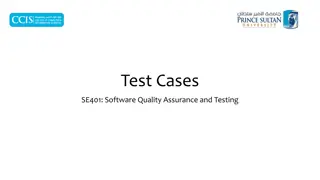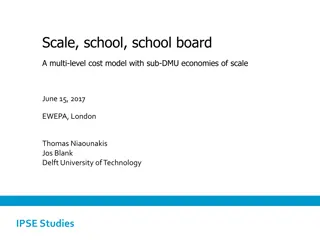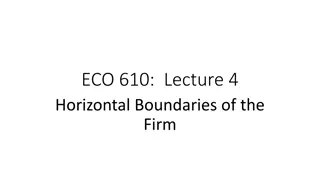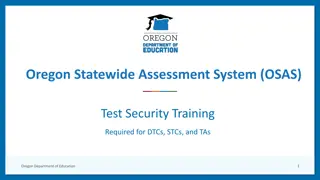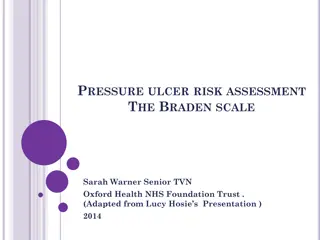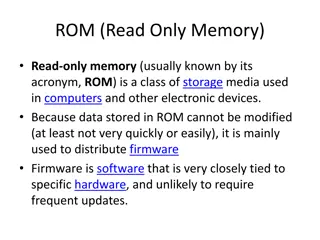A3 ROM Cost Assessment & Full Scale Test Estimate
This document outlines the process and tasks involved in assessing the cost estimate for A3 ground test equipment, including evaluating equipment needs, estimating engineering costs, developing equipment lists, and identifying safety-related systems. It also details the breakdown of systems and subsystems for the A3 Full Scale ROM Assessment at the NTP Ground Test Facility. The assessment involves addressing identified gaps, developing functions for additional systems, and estimating equipment types, sizes, safety functions, and electrical needs.
Download Presentation

Please find below an Image/Link to download the presentation.
The content on the website is provided AS IS for your information and personal use only. It may not be sold, licensed, or shared on other websites without obtaining consent from the author.If you encounter any issues during the download, it is possible that the publisher has removed the file from their server.
You are allowed to download the files provided on this website for personal or commercial use, subject to the condition that they are used lawfully. All files are the property of their respective owners.
The content on the website is provided AS IS for your information and personal use only. It may not be sold, licensed, or shared on other websites without obtaining consent from the author.
E N D
Presentation Transcript
A3 ROM Cost Assessment 27 June 2017 .1
A3 ROM Cost Assessment Statement of Work Sub Task 6 A3 Full Scale Test ROM Estimate Assessment BWXT activities include: Evaluate equipment/system needs and quantities from the structures, systems, and components described in the A3 test stand gap assessment document NASS ES 100889 Provide the quantities of mechanical, electrical, and I&C hardware required to meet the requirements of the conceptual A3 test stand design Provide input to NASA for creation of a ROM cost estimate of the equipment Estimate engineering and licensing costs for A3 ground test .2
A3 ROM Cost Assessment Process to develop equipment list Review NASS ES 100889 and develop a high level process flow diagram for each system identified. No design work performed Estimate operating philosophy Identify equipment required Estimate layout to determine feet of pipe/duct required Perform preliminary sizing for equipment identified Develop equipment list for each system Estimate which systems will be safety related Perform similar tasks for electrical and I&C systems/equipment .3
A3 Full Scale ROM Assessment NTP GROUND TEST FACILITY Existing NASA ground test concept divided into 22 systems /subsystems Additional 21 systems were identified to address identified gaps Develop functions and concepts for the additional systems Evaluate equipment types and sizes, approximate instrument and electrical needs, estimate safety related functions and equipment CONTROL ROOM SHIELDING SIMULATOR ELECTRICAL SECURITY RADIOACTIVE WASTE MANAGEMENT AUXILIARY SUPPORT SYSTEMS H2 / REACTOR COOLANT DIGITAL CONTROL FUEL HANDLING & STORAGE EXHAUST CAPTURE REACTOR DATA GAS RAD WASTE MANAGEMENT H2 SUPPLY & INJECTION FUEL & FUEL ELEMENTS AQUISITION LAYER FRESH FHS TEST CELL GAS SUPPLY FACILITY PROTECT LAYER LIQUID RAD WASTE MANAGEMENT CONTROL DRUMS EXHAUST DIFFUSER WATER SUPPLY TURBO PUMP SPENT FHS NOZ & SUPPORT COOLING FACILITY CONTROL LAYER IGNITION & AFTERBURN- ING SOLID RAD WASTE MANAGEMENT FIRE REFLECTOR PROTECTION TEST ARTICLE CONTROL LAYER FLAMMABLE GAS MONITORING Core Flow Distribution POST IGNITION COOLING MODERATOR DECAY HEAT REMOVAL NUCLEAR INSTRUM RADIATION MONITORING EXHAUST CW AIR SUPPLY EMERGENCY H2 CORE COOLING CHILLED WATER SUPPLY VESSEL DEBRIS TRAP WASTE WATER EFFLUENT WATER HANDLING ULTIMATE HEAT SINK NOZZLE SAMPLING KEY: NASA/AR EFFLUENT GAS HANDLING NONRAD DRAIN SYSTEM RADIOLOGICAL DRAIN BWXT Not Part of ROM COMMUNICA- TION SYSTEMS VENTILATION SYSTEMS NTP-GTF Systems Breakdown (BWXT: NASS-ES-100889) .4
Design Aspects Influencing ROM Baseline design based on April 20 meeting: .6
Design Aspects Influencing ROM Design Differences Nuclear Cooling / Confinement Influence Spray/Diffuser Cooling Once through De-ionized (DI) water Use of Higher Pressure Industrial Water (HPIW) to cool diffuser and condense the exhaust Gas removal from exhaust storage Work completed that applies to current design LH2 and LO2 supply Cooling required for fuel quenching Test Cell Effluent Gas Handling .7
ROM BOM Approach Focus on systems needed to license the design with the US Nuclear Regulatory Commission Consider events that will influence the design Results in additional systems and/or requirements Decay Heat Removal Emergency Core Cooling Requirements on LH2, LO2, Cooling Water supply Shielding Radiation Monitoring Radwaste systems Severe Accident Mitigation Core relocation .8
Event Considerations Influencing ROM Normal Operation: Power Operation o Assume No Fuel Leakage, No Radiation Outside of Shield Test Cell o Assume Partial Fuel Leakage, or Shine through Diffuser Startup Conditions o No Fuel Leakage (New Fuel) Shutdown Conditions o No Fuel Leakage (Spent Fuel) o Shutdown Conditions (Assume Partial Fuel Leakage, Shine where fuel relocation has occurred) .9
Event Considerations Influencing ROM Potential Maximum Hypothetical Events: Pipe Break/Loss of Hydrogen Coolant At Power Conditions Loss of Diffuser Active Cooling Resulting in Fire Severe Accident: Complete Relocation (One Piece), Core Critical In slides below: Red reflects a difference with the current concepts as we understand. Black is expected. Figures based on new concept for discussion. Where an item was previously noted, it was not included again to help simplify .10
Event Considerations Influencing ROM Normal Power Operation Power Operation, Assume No Fuel Leakage, No Radiation Outside of Shield Test Cell o H2/Reactor Coolant Core Heat Removal (Potentially Safety Related) o Reactor o Digital Control o Exhaust Capture o Auxiliary Support Systems Process and Effluent Radiation Monitoring. (Potentially Non- safety Related) o Electrical Systems o Security Control .11
Event Considerations Influencing ROM Related to Figure Provided: Core Heat Removal Process & Effluent Rad. Monitoring .12
Event Considerations Influencing ROM Normal Power Operation (Cont.) Power Operation, Assume some Radionuclide transport from Fuel, or Shine through Diffuser o H2/Reactor Coolant Core Heat Removal (Potentially Safety Related) o Reactor o Digital Control o Exhaust Capture o Auxiliary Support Systems Radiation Monitoring. (Potentially Non-safety Related) Dedicated Rad Systems (Drains, HVAC) o Radioactive Waste Management (Potentially Non-safety Related) o Electrical Systems o Security Control o Shielding Assumed 1% Leakage of Fission Products .13
Event Considerations Influencing ROM Related to Figure Provided: Dedicated Rad Systems Not Shown (Drains/HVAC), radiologically controlled area unclear. Shielding (Esp. For Neutrons/ Gammas) Radwaste Management (Not shown) .14
Event Considerations Influencing ROM Normal Power Operation (Cont.) Startup Conditions, No Fuel Leakage: o Air/Fuel Transfer (New Fuel) Fuel Handling & Storage o N2/Inert o H2/Reactor Coolant o Reactor o Digital Control o Exhaust Capture o Auxiliary Support Systems Process and Effluent Radiation Monitoring. (Potentially Non- safety Related) o Electrical Systems o Security Control .15
Event Considerations Influencing ROM Normal Power Operation (Cont.) Shutdown Conditions, No Fuel Leakage: o Air/Fuel Transfer (Spent Fuel) Fuel Handling & Storage (Potentially Safety Related and Non safety related, Augmented Quality) o N2/Inert o H2/Reactor Coolant Transition to Decay Heat Removal (Potentially Safety Related) o Reactor o Digital Control o Exhaust Capture o Auxiliary Support Systems Process and Effluent Radiation Monitoring. (Potentially Non- safety Related) o Electrical Systems o Security Control o Shielding .16
Event Considerations Influencing ROM Related to Figure Provided: Spent Fuel Handling and Storage Not Shown Intended Configuration for Decay Heat Removal Unclear .17
Event Considerations Influencing ROM Normal Power Operation (Cont.) Shutdown Conditions, Assume Partial Fuel Leakage, Shine where fuel relocation has occurred: o Air/Fuel Transfer (Spent Fuel) Fuel Handling & Storage (Potentially Safety Related and Non safety related, Augmented Quality) o N2/Inert o H2/Reactor Coolant o Reactor o Digital Control o Exhaust Capture o Radioactive Waste Management (Potentially Non-safety Related) o Auxiliary Support Systems Process and Effluent Radiation Monitoring. (Potentially Non- safety Related) Dedicated Rad Systems (Drains, HVAC) o Electrical Systems o Security Control o Shielding .18
Event Considerations Influencing ROM Maximum Hypothetical Events Pipe Break/Loss of Hydrogen Coolant From At Power Condition o H2/Reactor Coolant Pressurized Test Cell Engineering Safeguards - Emergency Hydrogen Core Cooling (Potentially Safety Related) Engineering Safeguards - Transition to Decay Heat Removal (Potentially Safety Related) o Reactor Reactor trip using Control Drums (Potentially Safety Related) o Digital Control Facility Protection Layer (Potentially Safety Related) o Exhaust Capture (Portions potentially Safety-Related) o Auxiliary Support Systems Radiation Monitoring. (Potentially Non-safety Related) Cooling Water (Potentially Safety Related) Spray Water (Potentially Safety Related) .19
Event Considerations Influencing ROM Maximum Hypothetical Events (Cont.) Pipe Break/Loss of Hydrogen Coolant From At Power Condition (Cont.) o Radioactive Waste Management (Non-safety, Augmented Quality) o Electrical Systems Divisional support of electrical systems. (Potentially Safety Related) o Security Control o Shielding Assumed Partial Core Relocation Due to Structural Degradation o Structural Support (Potentially Safety Related) .20
Event Considerations Influencing ROM Related to Figure Provided: Safety Related Cooling Function? Must assure redundancy, diversity and separation for those items deemed safety related. Test Cell Pressurization No Configuration for ECC Present Potentially Safety Related Particulate Transfer Handling Unclear Completely Passive System for normal operation with turbo pumps, as compared to safety case uncertain. .21
Event Considerations Influencing ROM Maximum Hypothetical Events Loss of Diffuser Active Cooling Resulting in Fire o H2/Reactor Coolant o Reactor Reactor trip using Control Drums (Potentially Safety Related) o Digital Control Facility Protection Layer (Potentially Safety Related) o Exhaust Capture o Auxiliary Support Systems Cooling Water (Potentially Safety Related) Spray Water (Potentially Safety Related) Radiation Monitoring. (Potentially Non-safety Related) .22
Event Considerations Influencing ROM Maximum Hypothetical Events Loss of Diffuser Active Cooling Resulting in Fire o Radioactive Waste Management (Potentially Non-safety, Augmented Quality) o Electrical Systems Divisional support of electrical systems. o Security Control o Shielding Assumed Partial Core Relocation Due to Structural Degradation. o Structural Support (Potentially Safety Related) .23
Event Considerations Influencing ROM Related to Figure Provided: What assures mission of cooling diffuser? Must assure redundancy, diversity and separation. .24
Event Considerations Influencing ROM Severe Accident Complete Core Relocation (One Piece), Core Critical o Digital Control o Exhaust Capture Missile Protection Water Management to avoid steam explosion. o Auxiliary Support Systems Radiation Monitoring. (Potentially Non-safety Related) Dedicated Rad Systems (Drains, HVAC) o Radioactive Waste Management (Potentially Non-safety, Augmented Quality) o Electrical Systems o Security Control o Shielding o Robust External Structure .25
Event Considerations Influencing ROM Related to Figure Provided: No Debris Trap/Water Management shown. What mitigates steam explosion in the event of complete core relocation? .26
Next Steps Design and Licensing processes are developed together BWXT has the expertise to both complete and integrate processes Design experience with other nuclear designs and NASA concepts gained through the ROM BOM process BWXT has broad design and licensing experience 13 NRC issued licenses to fabricate, process, utilize and store nuclear materials Provided design and licensing support to nuclear utilities for 34 nuclear power plants NRC pre-application work for MIPS non power reactor Currently fabricates the fuel assemblies for HFIR, ATR, MITRR Past specialty work efforts on SNTP and JIMO projects .27










